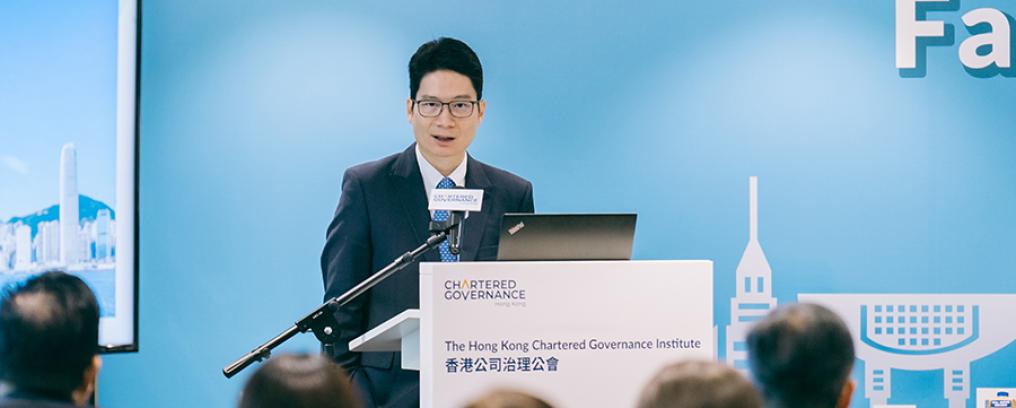CGj talks to Ellie Pang FCG HKFCG(PE), Institute Chief Executive, about the journal’s transition to a paperless format starting next month and about the Institute’s plans for the journal’s website going forward.
Highlights
- the revamped CGj website will offer readers real-time updates about the Institute’s latest research, articles and information, helping them to stay current in their professional knowledge
- relevant information will be searchable and available from anywhere with an internet connection, making it more convenient for members to stay connected and informed
- the transition to paperless will also enable the journal to improve the reader’s experience with additional multimedia elements, such as videos and interactive graphics
Can we start by discussing the reasons the Institute has opted to transition to a paperless journal?
‘The primary reason is of course to reduce the use of paper as part of the Institute’s continued effort to adopt sustainable practices in its operations. A second and no less important reason is to modernise and upgrade our communications with members, students and the wider community in this increasingly digitalised world. This is also the approach taken by a number of other professional bodies.’
CGj has been available online for a number of years – can you share with us the number of readers who have transitioned from the paper to the digital version?
‘Over the years, more and more members and students have opted to receive the digital version of the journal. The number as it currently stands is 6,851.’
Why do readers prefer the digital journal?
‘Before the internet, the journal was the main channel of communication between the Institute and its members. Readers received nearly all of their information about the Institute, including updates about training and membership events, and promotions and job opportunities, from the journal. Over the years, CGj has been the pride and joy of the Institute, with the brilliant writer Kieran Colvert being the much-loved and respected editor of the journal.
After the transition to digital, the journal will continue to serve as an important medium for members to learn about legal and regulatory updates, as well as frontier topics in governance, risk and compliance. What is changing is the means of delivery. From speaking to members and others, I understand that people’s reading habits have changed. The vast amount of information available on the internet and the limited time available for reading has meant that our readers are looking for quick and easy access to relevant topics of interest.
The digital version will also be much more searchable. Few readers will have the space to keep an archive of hard copies going back many years and, even where the hard copies are available, searching for content is difficult outside the digital context. A few key words will be all that it takes to find relevant content.’
What is your estimate of the environmental gains of going paperless?
‘In the past few years we have been encouraging CGj subscribers to go green and opt for digital copies instead of hard copies. However, we are currently still printing 4,000 copies of the journal per month and that requires a lot of paper. Moreover, given the changes to reading habits discussed above, I am not sure that all of those copies get read.’
Do you have a message for the readers who haven’t yet opted for the digital journal?
‘All the current features of the journal will remain intact. We will continue to have Harry Harrison’s cartoons on the cover and the high editorial standards will remain unchanged. The new means of delivery will, however, enable us to introduce more exciting and interesting new content, such as featured video interviews of governance professionals and others.’
When will the new CGj website be launched?
‘We will launch the revamped CGj website in January 2024.’
Looking further ahead, what are the Institute’s plans for CGj in the future?
‘In addition to saving paper and being more environmental, we hope to be able to modernise and upgrade the way we communicate with our readers. Hopefully the content will be more interesting to read, and more in tune with the way people read and search for information.’
What will be the main benefits of transitioning to a live and interactive CGj website for members of the Institute?
‘The revamped CGj website will offer readers real-time updates about the Institute’s latest research, articles and information, helping them to stay current in their professional knowledge. Moreover, this information will be available from anywhere with an internet connection, making it more convenient for members to stay connected and informed. Another major benefit is the fact that the website can incorporate multimedia elements, such as videos and interactive graphics, to enhance the learning experience. As mentioned above, it will also make the information more easily searchable, allowing members to find specific articles or topics quickly.’
What will be the main benefits of this transition for the Institute itself – in particular, will it help attract younger members?
‘Certainly, adapting to changing trends and technologies will make the Institute more appealing to younger generations, but more broadly the transition is also about modernising the Institute. It will help us to build:
- enhanced relevance – helping us stay relevant in our field and address current challenges
- improved efficiency – streamlining our operations with up-to-date systems and processes
- broader reach – embracing new tools and platforms that can help the Institute reach a wider audience
- increased innovation – encouraging innovation among our members and staff, and
- long-term sustainability – ensuring the Institute’s sustainability is essential for the future and is aligned with the Institute’s theme of “resilience in governance”.’
Since you became the Institute’s Chief Executive in 2020, you have played a major role in helping the Institute to evolve into its current form. Do you see the changes we have discussed above as part of that same journey?
‘Totally. We renamed the Institute in July 2021 and, a few months later, rebranded the Institute with a new logo and slogan. In that year we also launched a much-improved website as part of our wider IT system upgrade. I think our members expect us to keep up with major trends by modernising the Institute’s operations and continuing to demonstrate care for the environment and the community around us.’
SIDEBAR: The art of visual storytelling: Harry Harrison talks about his work for CGj
As mentioned in the main article, this journal’s evolution from printed format to interactive website will not be jettisoning one of the critical innovations that have defined its look and feel over the last decade – Harry Harrison’s cover illustrations.
CGj has a remit to inform, update and inspire readers with a lively and intellectually stimulating editorial and design, and no part of the journal does this with more humour and style than its covers. Harry has been illustrating CGj’s covers since 2012 and his drawings have come to be an important part of how the journal communicates with readers. For these reasons, his cover illustrations will continue to be the journal’s ‘front door’ – encapsulating each edition’s cover theme, but also setting the mood and resonating with users on levels that words cannot reach.
You are well known for your work with the South China Morning Post – is it different working outside the news context? In particular, how do you come up with your ideas for the CGj covers and is it a challenge to illustrate abstract concepts like good governance and ethics?
‘To come up with ideas for the cover, I read the main article to understand the headline concepts and try to find something that sums up the overall topic. That’s what the illustration side of my job entails, whether it be for magazines, articles or books. Regardless of the topic, this is about translating the words into pictures.
Where possible, I try to include something topical and that links to the other side of the work I do for the newspaper. Although the two disciplines are very different, my experience trying to sum up day-to-day political and social issues comes in very handy for approaching the more abstract concepts featured in CGj.’
Could we talk about the cast of characters in your cartoons? The line-up in your CGj covers frequently includes directors, regulators and, before the relaunch of the journal in February 2022, the Institute’s former icon – the Secretary Bird (sagittarius serpentarius), more familiarly known as ‘Saggy’.
‘Before the Institute’s change of name and logo, Saggy was a nice character to use – providing an instantly recognisable icon but also having a bit of fun with the corporate image of CSj, as the journal was known. It was, however, quite limiting in terms of my options for illustrating the cover topics, not least because it was hard to fit diverse elements into the previous cover layout.
The new design is a much more open page with lots of nice white space, and that gives me more flexibility to draw what I want without being limited to including a large Secretary Bird. Thus I’m able to incorporate any characters I’ve developed over the years to represent my interpretation of the various characters in the world of business. Of course, my years of newspaper cartooning have led me to always enjoy drawing the miscreants, rather than the people who are doing things the right way, although they can be included to show up the misdoings of the others if necessary.’
What is your method for drawing the CGj covers and has that changed over the course of the 11 years that you have been working with CGj?
‘For Saggy, I would start out with a pencil drawing to get the idea approved, and then use that as a template in Photoshop. For the final drawing, I would use colour fills and airbrush techniques – there would be no actual line work in those. When the design changed, although I would start with the same initial pencil rough for approval, I would use pen and ink with watercolour on watercolour paper for the final drawing.
To work traditionally on paper, I need a scanner, a computer, often a printer for printing out layouts, a lightbox for inking up the layout onto watercolour paper, plus a variety of dip pens, inks and watercolours. I’m freelance so I can’t take indefinite time off work – no work means no pay – so if I need to travel, getting access to all that equipment would be a challenge. During Covid the possibility of getting stranded somewhere in a lockdown, or in quarantine on my return to Hong Kong, made this even more of an issue.
To remedy this and make myself more flexible, I bought a tablet and stylus. Using an illustration app, I am able to do drawings from pencil rough stage through to the finished illustration using one piece of equipment. This came in very handy when I was stuck in quarantine and had to continue my regular work on a daily basis. One of the jobs I had to do was the CGj cover, and I enjoyed doing it on the iPad so much that I have continued doing so to this day.
Stylistically, the drawing is the same as what I was previously doing on watercolour paper, but without needing all the equipment and a lot more flexibility to “undo” bits I don’t like – you can’t do that on watercolour paper. The app I am using also provides you with a nice little time-lapse video of the entire illustration in progress. All in all, perfect for this new digital nomad age.’
“in addition to saving paper and being more environmental, we hope to be able to modernise and upgrade the way we communicate with our readers”



